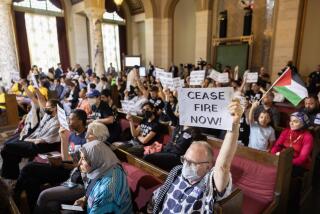New Coalition Seeks Increased Funding for Anti-Gang Efforts
As a newly formed coalition of anti-gang activists called for more funding Wednesday to stem a surge in violence in South Los Angeles, police released the identities of two men killed Tuesday in a suspected gang shooting at the Fox Hills mall in Culver City.
Coalition members said the recent increase in gang violence is due partly to tension between black and Latino gangs who are warring over drug sales. They called for an increase in jobs and training programs in the inner city.
“This is a people problem not a black or brown problem,” said V.G. Guinses, executive director of Save Every Youngster Youth Enterprise Society, one of the city’s oldest anti-gang programs.
Guinses was among half a dozen Latino and African American gang intervention activists who announced the formation Wednesday of a coalition to lobby local and federal officials for increased funding for anti-gang programs.
Rep. Maxine Waters (D-Los Angeles) met with the group Saturday and has offered to help it apply for federal and local grants.
The coalition also plans to petition the Los Angeles County Board of Supervisors on Tuesday for increased funding for anti-gang programs.
“This is not just a citywide problem, it’s a countywide problem,” said Chilton Alphonse, founder of the Community Youth Sports and Arts Foundation.
The announcement of the coalition’s creation came one day after a gun battle between rival black gangs erupted on the roof of the Fox Hills mall and claimed the lives of Ernest E. Dabbs, 20, of Venice and Richard Lloyd Brewer Jr., 19, of Los Angeles, according to county coroner’s spokesman Scott Carrier.
One of the men was fatally shot in the passenger seat of a white Cadillac, while the other lay dead nearby on the rooftop level of the mall’s parking lot, Culver City police said.
Police could not say whether the men had been shot by rival gang members or by two plainclothes police officers who happened to be eating in the mall’s food court and joined the fray when shooting broke out between two groups of young men.
Three men were wounded in the melee. Two were taken to UCLA Medical Center, where one 20-year-old with a head wound was listed in critical condition and a 19-year-old with wounds to the chest and shoulder was listed in fair condition.
A third victim was taken to Daniel Freeman Hospital by a friend, where he was treated and released. None of the identities of the wounded were released.
In all, about 25 shots were fired by eight to 10 men and the two police officers, sparking panic at the popular mall, police said.
Culver City police, who say they are getting conflicting stories from witnesses and family members, had yet to make any arrests in the shootings Wednesday. The two killings have doubled the number of homicides in Culver City since the beginning of the year.
Police declined to identify the gangs involved, but Los Angeles Police Department gang experts say four gangs have been warring in that area for several months. What sparked the feuding Tuesday is unclear, police say.
What is clear is that an increase in gang violence, particularly in South Los Angeles, has driven up crime rates in Los Angeles for the first time in nearly five years.
Violent crime in the city is up 7% in the first seven months of the year over the same period last year, the LAPD said.
Most troubling, however is the 30% increase in homicides this year, from 210 killings as of July 14 last year to 274 in the same period this year. Nearly half of those homicides were gang-related, police said.
Gang-related homicides in the city have increased 131%, from 54 in the first six months of last year to 125 in the same period this year, according to Los Angeles police.
“We are sick and tired of having our kids killing each other on the streets,” Fernando Chacon, a director at El Centro Del Pueblo, an Eastside youth services program, said during a news conference Wednesday to announce the formation of the new coalition.
Alphonse said his program recently received a state grant to buy 35 computers to provide training for teenagers on probation in South Los Angeles.
“But we can only help 30 or 40 kids,” he said. “I want to train 10,000 kids from the community.”
More to Read
Sign up for Essential California
The most important California stories and recommendations in your inbox every morning.
You may occasionally receive promotional content from the Los Angeles Times.











